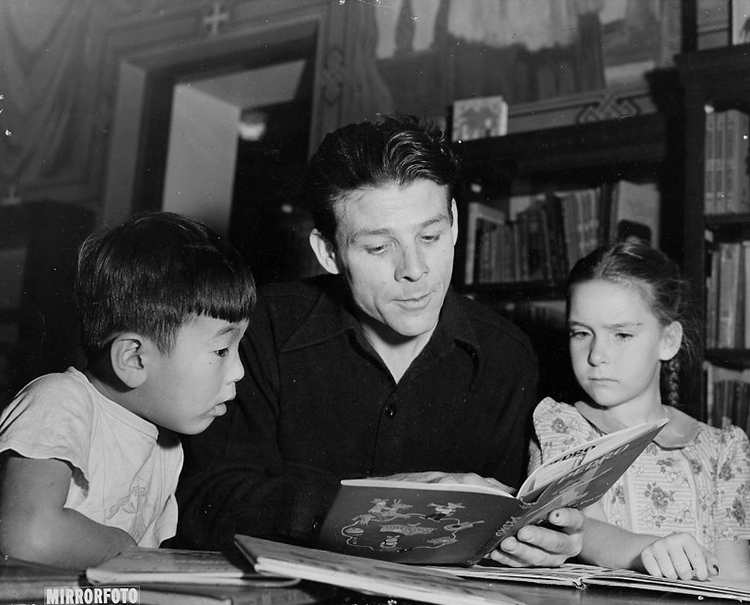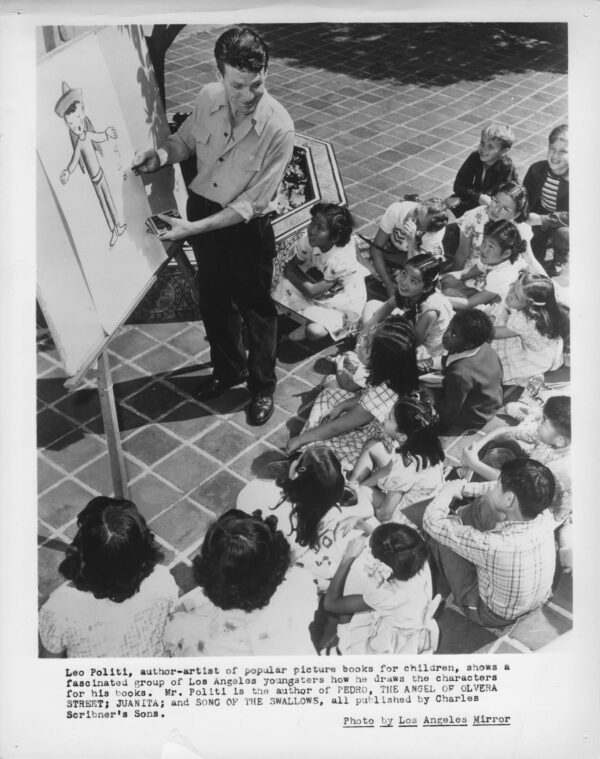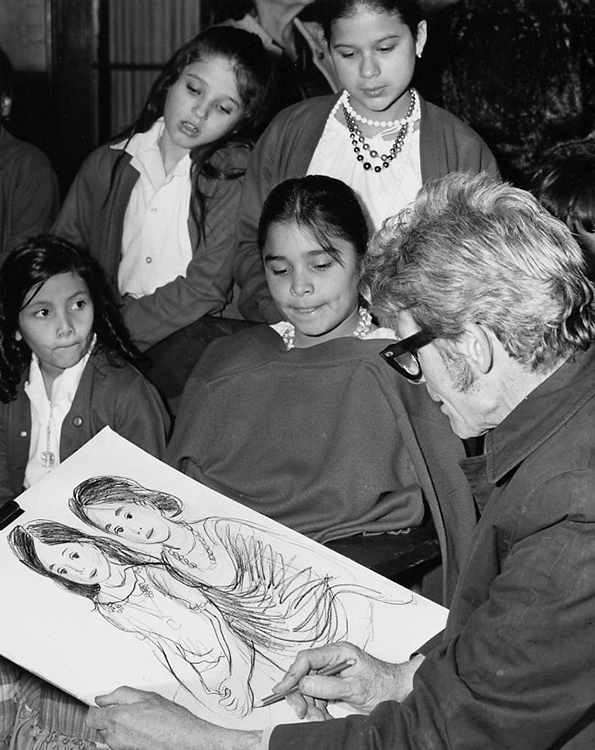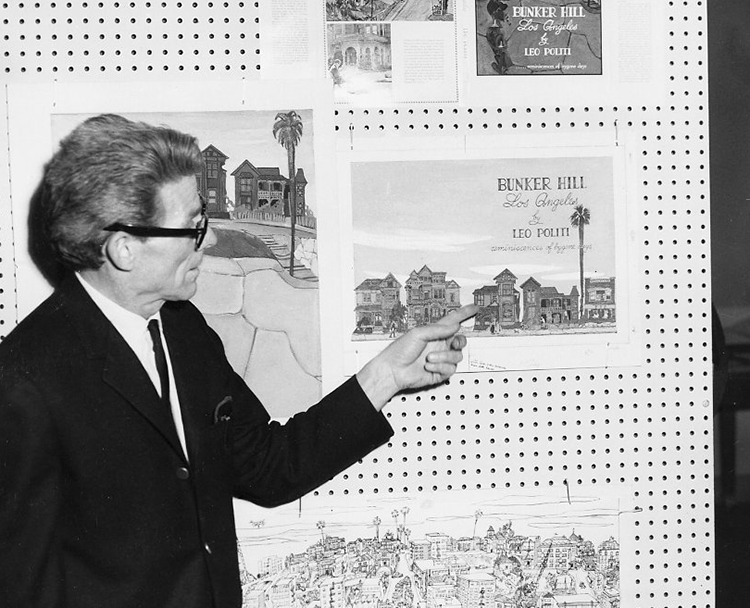Come on a trip with me. We'll time travel to 1938, a difficult time for the United States, slowly recovering from the economic disaster of the Great Depression, but a wonderful time for the recently revived Olvera Street in Los Angeles. The Mexican marketplace is thriving as a tourist attraction, lined with street vendors, restaurants, and gift shops offering handcrafted goods and Mexican folk art. It's late evening, so let's take a seat at the El Paseo Cafe, where on this cold night, if we're lucky, we might spot a young Italian-American artist busy at work, joined by his patiently waiting wife. Tonight, he might create a watercolor of the children running up and down the street or a sketch of the Mexican musicians singing near us. He might be creating a delicate carving from a discarded block of wood with nothing but a knife. We'll sit and watch him tirelessly work as he waits for customers that may or may not come. You might say, "My goodness, that fellow is working quite hard, I wonder what will become of him." And I will tell you, "That man is Leo Politi—and in the short order of a couple of decades, he'll become so well-known and admired in this City that his work will be praised as an 'indigenous part of California's landscape...never [to] die or be diminished in the hearts and souls of the public."
It is difficult to fully encompass the significance of Leo Politi's artwork and illustrations to the Los Angeles area because his contributions are prolific varied, and have proven truly enduring, as beloved now as they were when freshly made. Where can one even begin to describe Politi—the artist, the historian, and the award-winning children's book author? Perhaps it is judicious to start with his cherished children's books as these titles have cemented his legacy, introducing his illustrations to generation after generation of young readers.

Politi published over twenty children's books, including his most famous work, Song of the Swallows, winner of the 1950 Caldecott Medal for "most distinguished American picture book for children." His books are celebrated for their cultural diversity, historical depictions of Los Angeles, and Politi's unique ability to depict the playful curiosity of childhood. Politi admired the children of Los Angeles, sketched them often, and wrote "No Barrier" in 1934 to capture his sentiments:
"From a playground, we watch the children play. Some are light, others dark—but they are all beautiful. All of them have a life force animating their little bodies. All of them run, play, laugh, and cry, and yet, if outwardly they look different, they have the same emotions of life. Each enjoys living; all will later be in the arms of mothers who love them, live for them, and raise them to be good and kind. If we can only understand this force that makes them live—the same love between mother and child, the same desire that you and I have to live, the love—aspirations—dreams like your mother with you, my mother with me—then no dogmas, no prejudices, no fears can stand (as) barriers between man and man."
Politi's picture books explored the rich cultural traditions of Los Angeles long before the phrase "cultural diversity" existed in the American lexicon. Rosemary Livesey, a Los Angeles Public Library librarian and friend of Politi, wrote warmly in her 1949 Horn Book article, "Leo Politi, Friend of All," about Politi's appreciation for the children of Los Angeles. She described his frequent visits to the Children's Literature Department of the Central Library, commenting, "Mexican, Italian and [Asian]—they are the children of whom he thinks and whom he sees when he makes his books for all children." In fact, it is difficult to find anyone who had the pleasure of meeting Politi who doesn't have a kind story or a small piece of art to remember the encounter. Stories abound of his generosity and goodwill. During his visits to the Children's Literature Department, he would visit with librarians, read children's books, provide author programs, give weekly drawing demonstrations, and often sketch children in the department. His book, Pedro, the Angel of Olvera Street, won the first ever FOCAL (Friends of Children and Literature) Award in 1980 for "excellence in Children's literature with California theme." As a gift to FOCAL, in gratitude for the wonderful work they do to support the Children's Literature Department, Politi created their logo featuring a little boy and girl reading, which is still used today.


Politi did not just write picture books for the amusement of children; his illustrated history books for adults served to preserve the cultural and architectural history of Los Angeles. In "Bunker Hill, Los Angeles: Reminiscences of Bygone Days" (1964), Politi documented the rapidly vanishing Victorian homes of Downtown LA's upper-class neighborhood, capturing the unique personality of its residents. His illustrations were rich scenes of everyday life: passersby taking a stroll, neighbors gossiping on the porch, laundry hanging out to dry, children playing in the yard, dogs asleep, cats on the prowl, and even fireworks lighting the night sky on the Fourth of July. According to Ann Stalcup's account in Leo Politi: Artist of the Angels, Politi's wife, Helen, was very anxious about his efforts to document Bunker Hill, as he would often sketch while perched high on the roof of a house or office building to get just the "right angle" for his work. In fact, his drawing of the sprawling Bunker Hill neighborhood, in simple black and white lines on the end pages of his book, was created while Politi stood atop the old Water and Power Building. Those with a keen eye might spot that Politi even drew a tiny figure of himself (busy at work drawing, of course!) hidden among the parks and buildings of Bunker Hill. Politi continued to illustrate history in Tales of the Los Angeles Parks (1966) and The Poinsettia (1967), recording the parks and cultural traditions of Los Angeles with animation, emotive color, and a charming amount of personable details. His artworks beg to be explored repeatedly, with new, small features revealing themselves for the viewer's appreciation each time.

Given the beauty and historical value of Politi's Bunker Hill paintings, it is not surprising that in 1965, following an exhibit of his art at the Central Library, the librarians made a formal request to the Board of Library Commissioners to purchase a selection of Politi's paintings for the Los Angeles Public Library's Special Collections. According to records from the time, library staff felt the artworks held "historical value in depicting an era in the history of Bunker Hill" and wanted to add them to the library's growing Californiana collection. The Board of Library Commissioners approved an expenditure of $3,000 to purchase a selection of paintings used in the book Bunker Hill, Los Angeles: Reminiscences of Bygone Days—and what a good decision that was! Now, over fifty years later, Politi's paintings have only increased in historical value and public admiration, a true treasure for the Los Angeles Public Library to share with all Angelenos. In November of 2023, a selection of these paintings was placed in the Children's Literature Department at Central Library, joyfully at home among the picture books and children that so inspired Politi's art.
From humble beginnings as a street artist in Olvera Street, Politi's career has made him as much a part of the Los Angeles landscape as the architecture and neighborhoods he loved. His mural depicting the "Blessing of the Animals" tradition on the entrance of the Biscailuz Building, painted in 1978, serves as a lasting reminder of his influence and can still be admired today. This artwork has become iconic to the plaza it adorns, so much so that Los Angeles Mayor Tom Bradley declared April 1984 to be "Leo Politi Appreciation Month," with an olive tree and plaque honoring Politi placed near the mural to mark the occasion. In addition to this, Politi has been honored with the naming of Leo Politi Elementary School, located in Koreatown, Leo Politi Square, an intersection in Echo Park, and Montecillo De Leo Politi Park, a recreational area just north of Dodger Stadium. Politi is remembered for his beautiful artworks, historical illustrations, and lovable children's books, but his true legacy lives on through the stories of his creativity, kindness, and generous spirit, passed on by each generation in admiration of his work. Truly, as biographer Francis J. Weber said, an "indigenous part of California's landscape... never [to] die or be diminished in the hearts and souls of the public."
Leo Politi Biography
Leo Politi was born in Fresno, California, to Italian parents on November 21, 1908. When Politi was seven years old, his family returned to his mother’s hometown of Broni, Pavia, located in Northern Italy. Politi always loved to draw and was constantly sketching on scraps of paper. In 1923, when Politi was fifteen years old, he won a scholarship to the National Art Institute at the Royal Palace of Monza, near Milan, where he lived and studied drawing, sculpture, architecture, and design over the next six years.
Politi returned to the United States in 1930 and married Helen Fontes in 1934, renting a home on Bunker Hill in downtown Los Angeles. His first published illustration appeared as “Pancho,” a little Mexican boy featured alongside articles in the Los Angeles magazine Script. In 1938, Politi used this character to write his book, “Little Pancho'', the first of six picture books published by Viking Press. In 1946, Politi published his second book, Pedro, the Angel of Olvera Street, inspired by Olvera Street at Christmas time. It was during this period that Politi began making regular appearances at the Los Angeles Central Library and hosting weekly drawing demonstrations in the Children’s Literature Department. Other publications include Juanita (1948), Song of the Swallows (Caldecott Medal winner, 1950), Little Leo (1951), Moy Moy (1960) and Mieko (1969). In addition to his children’s books, Politi wrote and illustrated books for adults, sharing his love for historical Los Angeles. Politi passed away on March 26, 1996. He has been honored with the naming of Leo Politi Elementary School, located in Koreatown, Leo Politi Square, an intersection in Echo Park, and Montecillo De Leo Politi Park, a recreational area just north of Dodger Stadium.








